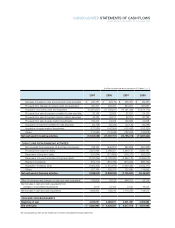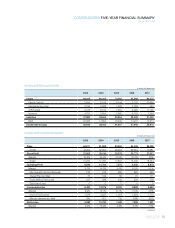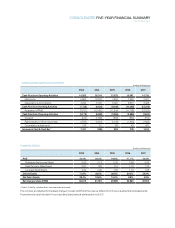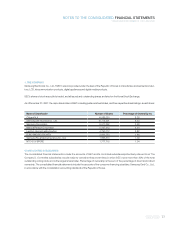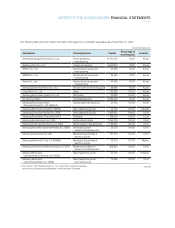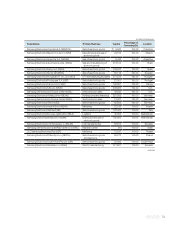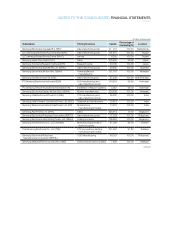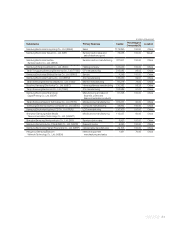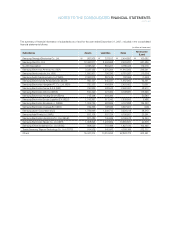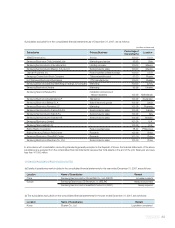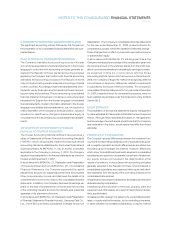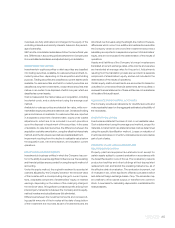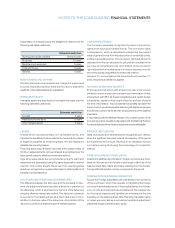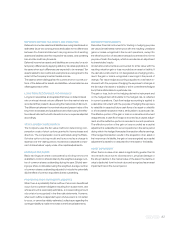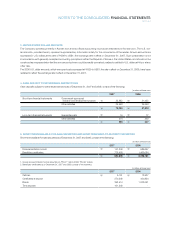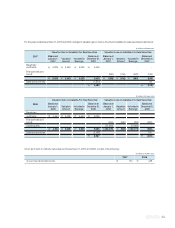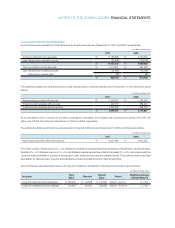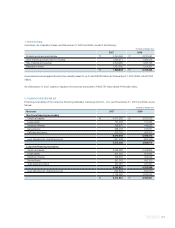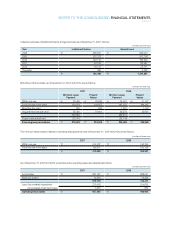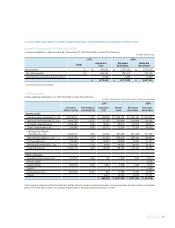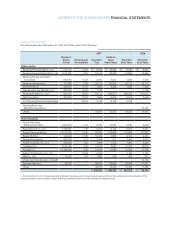Samsung 2007 Annual Report Download - page 86
Download and view the complete annual report
Please find page 86 of the 2007 Samsung annual report below. You can navigate through the pages in the report by either clicking on the pages listed below, or by using the keyword search tool below to find specific information within the annual report.NOTES TO THE CONSOLIDATED FINANCIAL STATEMENTS
continued
2. SUMMARY OF SIGNIFICANT ACCOUNTING POLICIES
The significant accounting policies followed by the Company in
the preparation of its consolidated financial statements are sum-
marized below:
BASIS OF FINANCIAL STATEMENT PRESENTATION
The Company maintains its accounting records in Korean
won and prepares statutory financial statements in the Korean
language in conformity with accounting principles generally ac-
cepted in the Republic of Korea. Certain accounting principles
applied by the Company that conform with financial accounting
standards and accounting principles in the Republic of Korea
may not conform with generally accepted accounting principles
in other countries. Accordingly, these financial statements are in-
tended for use by those who are informed about Korean account-
ing principles and practices. The accompanying consolidated
financial statements have been condensed, restructured and
translated into English from the Korean language consolidated
financial statements. Certain information attached to the Korean
language consolidated financial statements, but not required for
a fair presentation of the Company’s financial position, results of
operations or cash flows or changes in shareholders’ equity, is
not presented in the accompanying consolidated financial state-
ments.
APPLICATION OF THE STATEMENTS OF KOREAN
FINANCIAL ACCOUNTING STANDARDS
The Korean Accounting Standards Board has published a
series of Statements of Korean Financial Accounting Standards
(“SKFAS”), which will gradually replace the existing financial
accounting standards established by the Korean Financial and
Supervisory Board. As SKFAS No. 11, No. 21 and No. 24 became
applicable to the Company on January 1, 2007, the Company
adopted these statements in its financial statements as of and for
the year ended December 31, 2007.
In accordance with SKFAS No. 21, Preparation and Presentation
of Financial Statements and SKFAS No. 25, Consolidated
Financial Statements, the Company separated its capital
adjustments account into capital adjustment and accumulated
other comprehensive income, and disclosed the details of its
comprehensive income in the notes to the consolidated financial
statements. In addition, the Company disclosed its earnings per
share on the face of its statements of income and net incomes
of the controlling interests and minority interests were presented
separately on its statements of income.
In accordance with SKFAS No. 24, Preparation and Presentation
of Financial Statements (Financial Industry), Samsung Card Co.,
Ltd., one of SEC’s domestic subsidiaries, changed its account
classification. The Company’s consolidated financial statements
for the year ended December 31, 2006, presented herein for
comparative purposes, have been restated to reflect this change.
These changes had no effect on previously reported net income
or shareholders’ equity.
In accordance with SKFAS No. 23, Earnings per Share, the
Company now deducts any excess of the consideration given over
the carrying amount of the preferred shares from the profit avail-
able to common stockholders in calculating its earnings per share.
As explained in Note 24, in accordance with the K or ea
Accounting Institute Opinion 06-2 announced on December 29,
2006, the Company changed its method of recognizing deferred
income taxes on temporary differences related to investments
in subsidiaries and equity-method investees. The Company’s
consolidated financial statements for the year ended December
31, 2006, presented herein for comparative purposes, have not
been restated as permitted under the Korea Accounting Institute
Opinion 06-2.
USE OF ESTIMATES
The preparation of the financial statements requires management
to make estimates and assumptions that affect amounts reported
therein. Although these estimates are based on management’s
best knowledge of current events and actions that the Company
may undertake in the future, actual results may differ from those
estimates.
PRINCIPLES OF CONSOLIDATION
The Company records differences between the investment ac-
count and corresponding capital account of subsidiaries as good-
will or negative goodwill, and such differences are amortized over
five years using the straight-line method. However, differences
which occur from additional investments acquired in consolidated
subsidiaries are reported in a separate component of sharehold-
ers’ equity, and are not included in the determination of the
results of operations. In accordance with accounting principles
generally accepted in the Republic of Korea, minority interests in
consolidated subsidiaries are presented within equity and identi-
fied separately from the equity of the controlling interests in the
consolidated balance sheet.
All significant intercompany transactions and balances have been
eliminated during consolidation.
Unrealized profits included in inventories, property, plant and
equipment and other assets, as a result of intercompany transac-
tions, are eliminated.
Unrealized profits, arising from sales by the consolidated subsid-
iaries, or equity-method investees, to the controlling companies,
or sales between consolidated subsidiaries, or equity-method


